Duck Creek Project Converse County, Wyoming
Duck Creek Project Converse County, Wyoming
Summary:
Duck Creek project lies in TRS 37N 73W Sections 15, 16, 21, 28, 2, 3, 4 and 9 in Converse county Wyoming. The project covers a total area of 4,160 acres. That is 2560 acres covers the leases on state land on all the sections 15, 16, 21 and 28 and ~1600 acres on the parts of the sections 2, 3, 4, 9 on the federal land. All is owned by UNXE238 Corp.
As estimated by WWC Engineering there are 1.4-4.2 Mlb in the shallow Wasatch Formation based on the resource estimation based on 1492 drill holes; even though we have a total of 3508 drill holes on the property; So, the real potential could be much more than that.
The real potential is the highly mineralized Fort Union Formation at 600-1000 ft underneath Duck Creek project. This is very likely as the same sandstone have mineralization under Reynolds Ranch a mile to the west and the same sandstone extends underneath Duck Creek
Surrounding deposits, ISR operations and active exploration projects
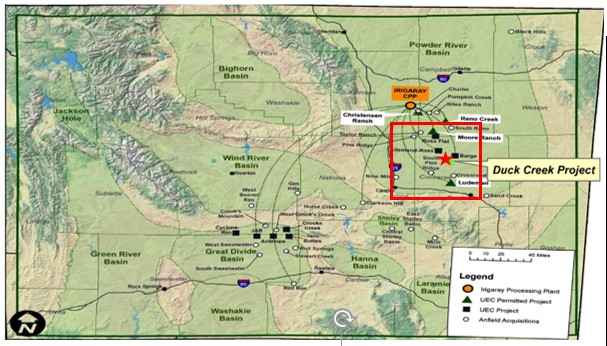
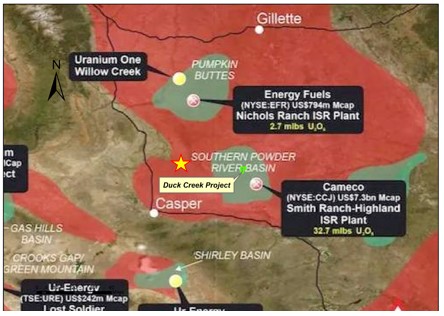
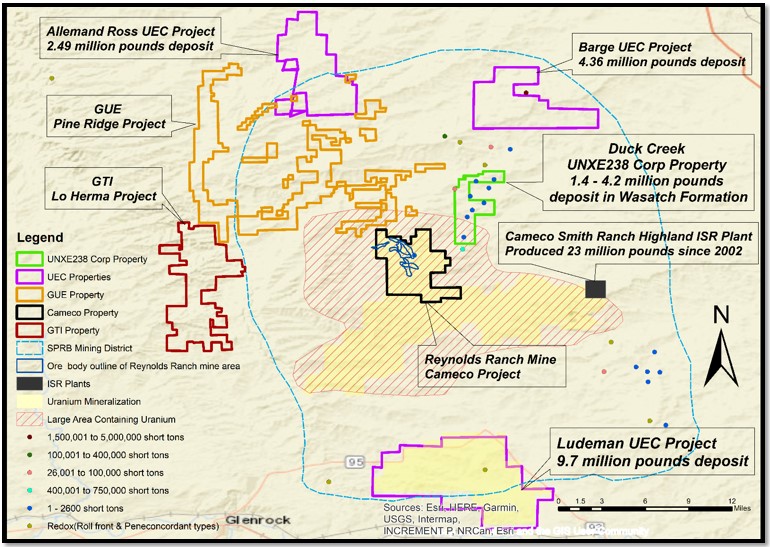
The project is about 5 miles, 7.5 miles and 12 miles south, southeast and north of Barge, Allemand Ross and Ludeman projects of UEC, respectively. The project is about 1 mile northeast of Smith –Reynold Ranch deposits.
Duck Creek project is located within the heart of most prolific part of southern Powder River basin
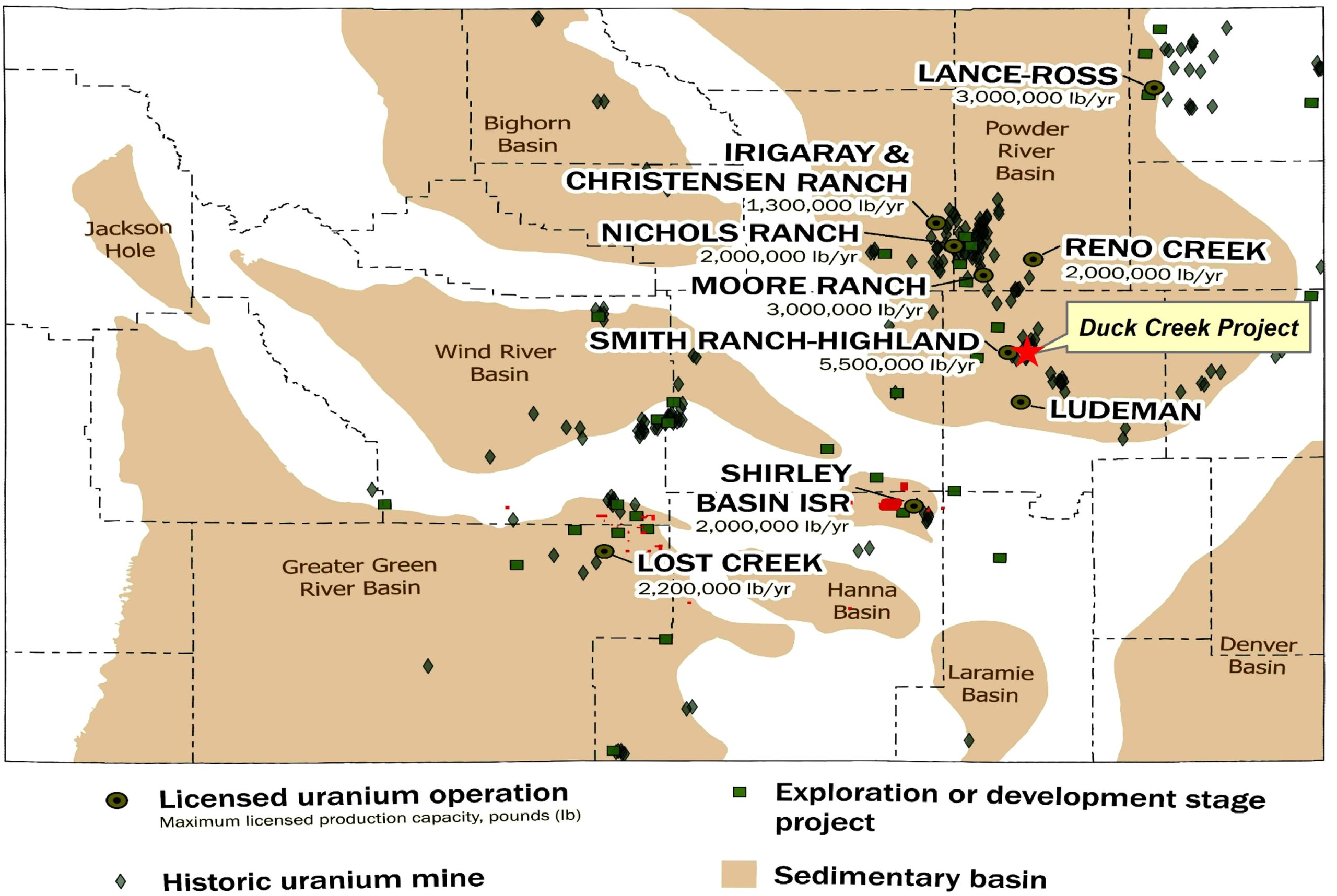
Duck Creek Project
- The projects located in the vicinity are Ludeman, Barge, Allemand Ross, Smith and Reynold Ranch.
- Cameco’s Smith Ranch Highland ISR plant is located just adjacent to our project.
- The inferred resource statistics of Allemand Ross is 12,75,000 Tons of Ore with 2.49 million pounds of U3O8.
- The measured and indicated statistics of Barge is 4,301,000 Tons of Ore with 4.36 million pounds of U3O8.
- The measured and indicated statistics of Ludeman is 5,334,000 Tons of Ore with 9.7 million pounds of U3O8.
- Cameco Smith Ranch ISR plant has produced 23 million pounds of U3O8 since 2002.
Duck Creek Project and surrounding deposits and historical mines
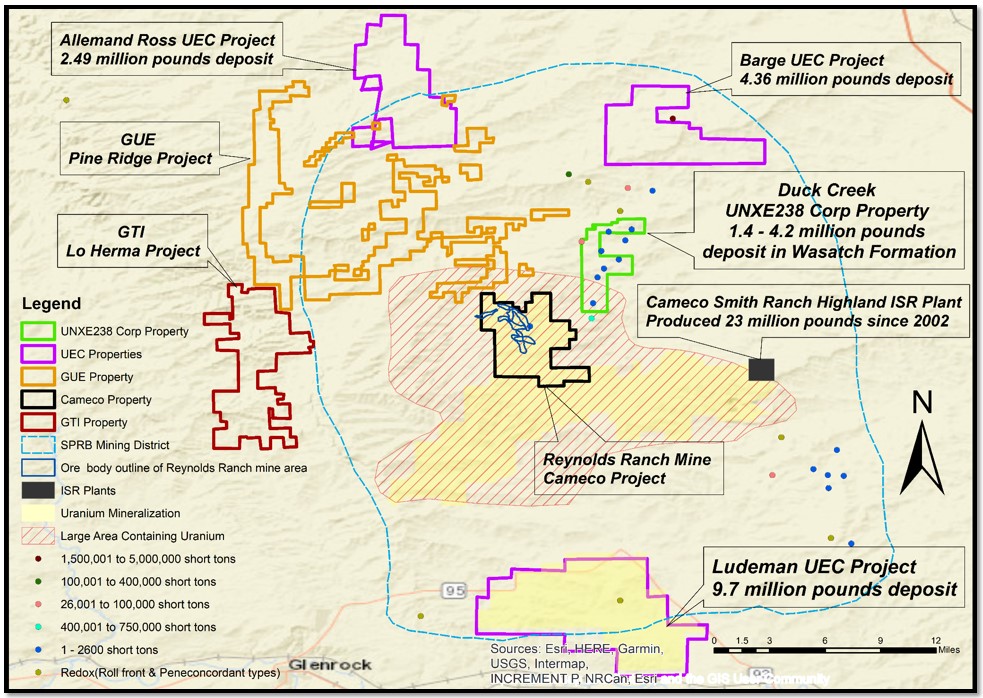
Mineralization is primarily in Wasatch Formation
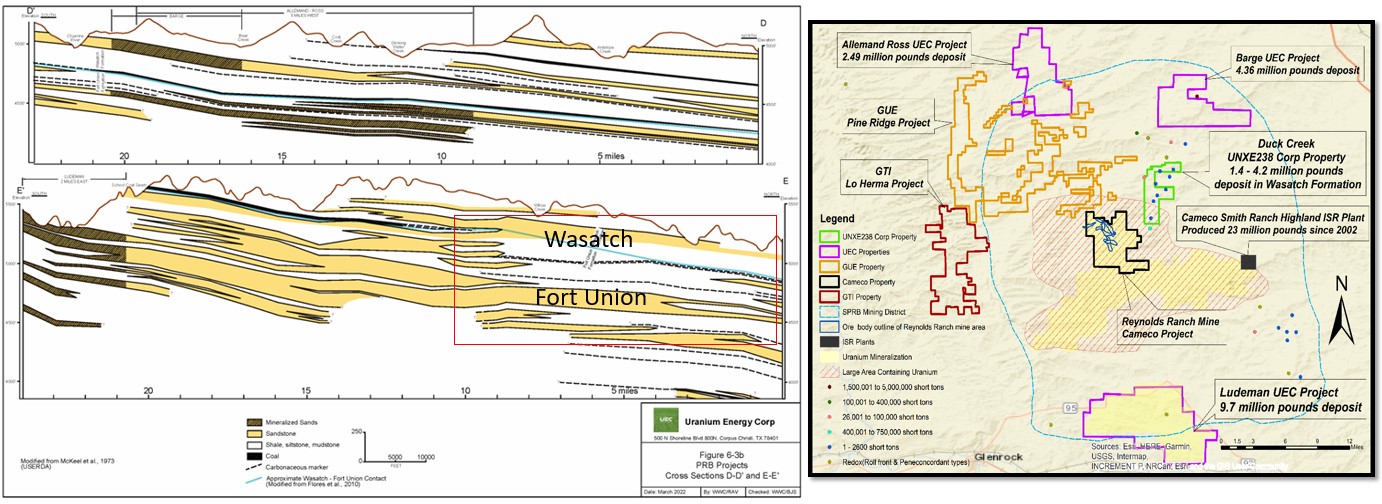
Drill Holes In Duck Creek Project
- The Duck Creek Project is located in Converse County, Wyoming, spanning Sections 15, 16, 21, 28, 2, 3, 4, and 9 in T37N R73W. The project covers a total area of 4,160 acres, with 2,560 acres leased on state land (Sections 15, 16, 21, and 28) and approximately 1,600 acres on federal land (portions of Sections 2, 3, 4, and 9).
- A total of 3,508 drill holes have been identified within the project. Of these, 1,492 drill holes have documented locations along with detailed information on mineralized zones, including depth to the top of the zone, thickness, and grade.
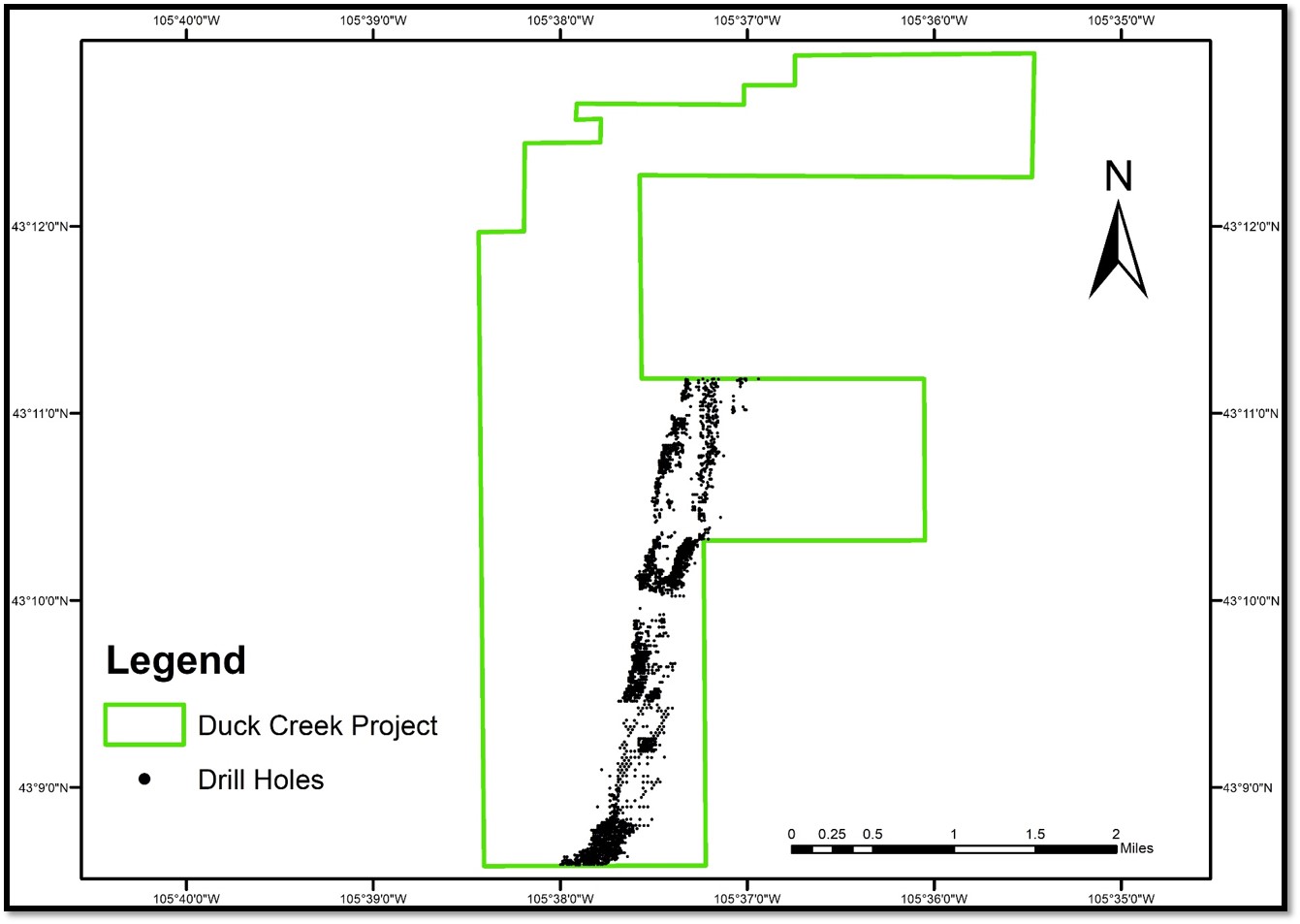
Highly mineralized Grade (>700 ppm) and mineralized polygons (300-700 ppm)
Note: It should be noted that there are number of places where polygons around highly mineralized spots were not drawn.
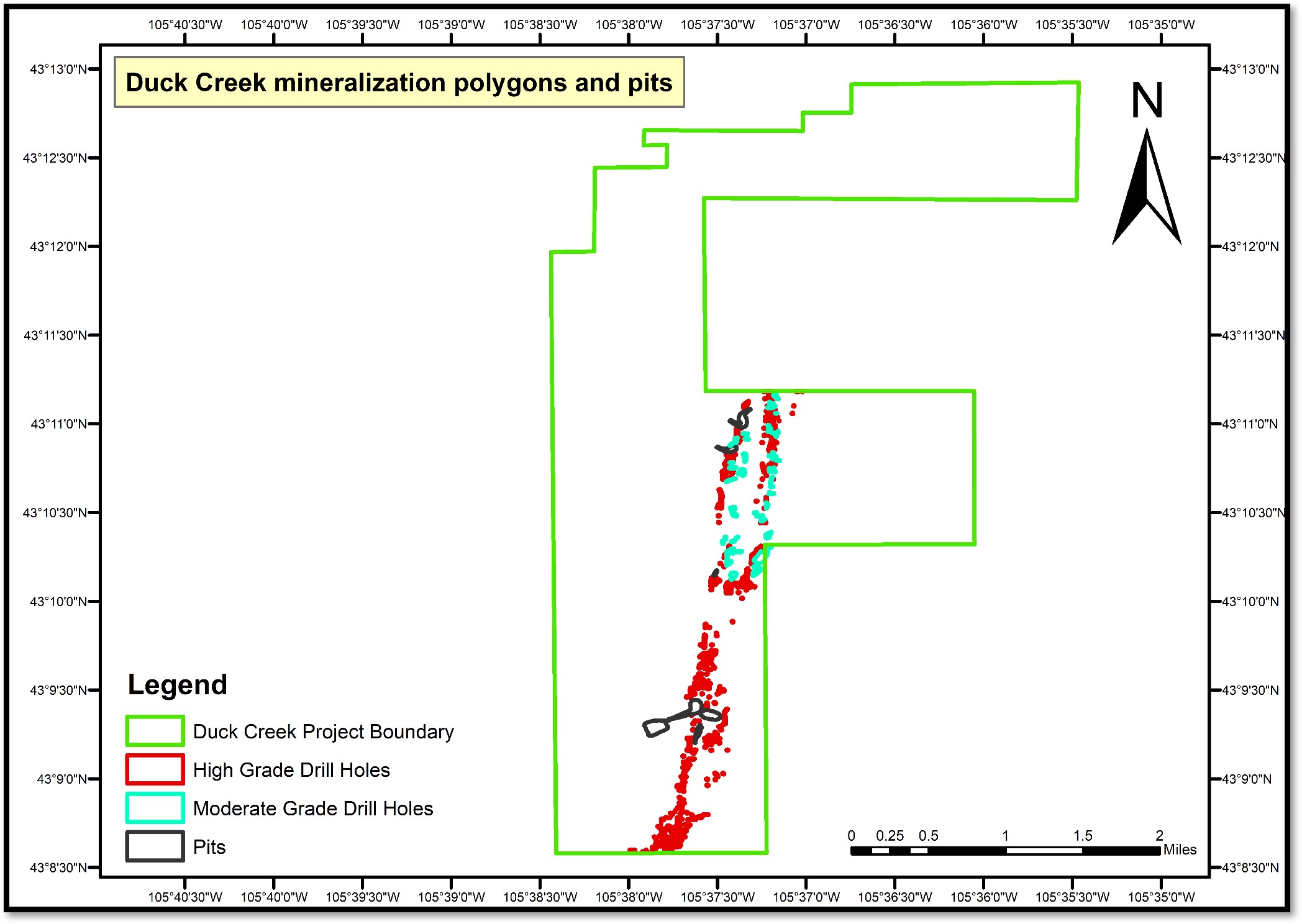
Mineralization in the region
The Barge project area to the north has mineralization both in the Wasatch Formation and the Fort Union Formation.
At the Barge project area, the “A sand” unit in the Wasatch Formation is the shallowest of four mineralized sand units.
The remaining mineralized sand units are in the Fort Union Formation. The A sand mineralized trend is located in the northern portion of the Barge project area and is approximately 4,500 ft long.
At the Allemand-Ross project area, the Fort Union Formation is divided into three members, with mineralized sands in the Lebo Member. However, in certain areas at the edge of the PRB, the contacts between members become uncertain and the Fort Union is broken up into two members, the Upper and Lower Fort Union Formation (Sharp and Gibbons, 1964). Mineralization at the Allemand-Ross project area is in five sandstone units, designated as the 10, 20, 30, 40 and 50 sands in ascending order. The thicknesses of the individual sand units range from less than 10 ft to over 150 ft.
Immediate to the east in Reynold Ranch deposit, mineralization is primality in deeper Fort Union Formation
Depth relationship indicates that the mineralization in Duck Creek project is primarily within the Wasatch Formation. Significant upside potential beneath Duck Creek project.
Historic Mines in Duck Creek Project
- There were numerous historic mines found in Duck Creek Project boundary.
- Historic mine D-85 having 4,720 Short Tons Ore Tonnage, ML 151 having 359 Short Tons Ore Tonnage, D-7 having 16,900 Short Tons Ore Tonnage, Section 21 having 1,391 Short Tons Ore Tonnage.
- The short tons of all mines located in the project boundary was not produced fully and were abandoned due to decline in uranium prices back in era 1990’s
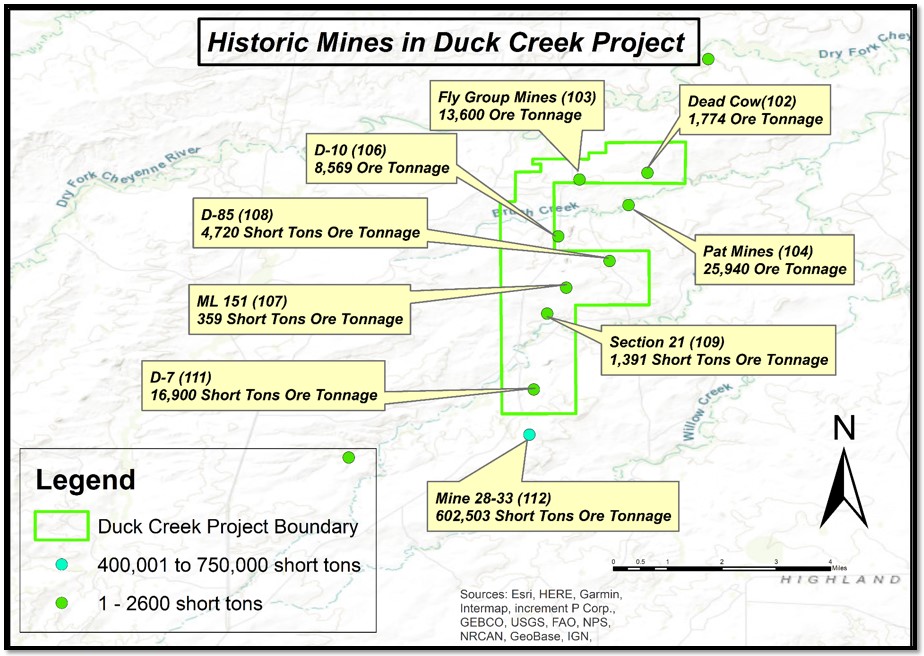
Project Description
- The Duck Creek uranium project is located in the Southern Powder River basin (PRB), Wyoming, USA.
- The project spans 2,560 acres across four State of Wyoming leases in T37N, R73W section 15,16,21,28
- BLM Land on section 2,3,4 and 9.
- Infrastructure: The project area is near existing uranium mining operations, which can support infrastructure development (e.g., roads, utilities, workforce)
Historical drilling and uranium resource estimates
Historical drilling efforts
Conducted by: Kerr-McGee Corporation (pre-1980s).
Total drill holes: 3,508.
Analyzed drill holes in resource prognosis: 1,492 (due to verified location and data quality).
Number of uranium intercepts recorded: 23,136.
Average drill hole depth: 258 feet, with only 15 drill holes reaching 500+ feet.
Primary target formation: Eocene Wasatch Formation (shallow uranium deposits).
Uranium Metal Quantity Estimates
- Calculation Based on: Grade-thickness (GT) factors and estimated mineralized area.
- Estimation Method: Median GT and minimum GT were applied to mineralized areas.
Key observations:
The upper range estimate (4.2 Mlbs U₃O₈) assumes a (median GT 0.598)
The lower range estimate (1.4 Mlbs U₃O₈) assumes a conservative cut-off GT of 0.201.
The data lacks geophysical logs and requires further drilling verification.
Table: Estimated Uranium Resources in Wasatch Formation
Estimate | Average Grade (%U₃O₈) | Grade Thickness (GT) | Area (sq ft) | Tons (000s) | Uranium Metal Quantity (Mlbs U₃O₈) |
Upper Range | 0.05 | 0.598 (Median GT) | 5,895,866 | 4,241 | 4.2 |
Lower Range | 0.05 | 0.201 (Minimum GT) | 5,895,866 | 4,241 | 1.4 |
Geological and Mineralization Characteristics
Host Rock and Deposit Type
- Primary Uranium-Bearing Formation: Wasatch Formation (Eocene Age)
- Composed of sandstone units that host roll-front uranium mineralization.
- Underlying Formation: Fort Union Formation (Paleocene Age)
- Known to contain significant uranium in adjacent projects.
- Exploration potential: Deeper drilling could reveal additional roll-front deposits.
Uranium Mineralization Process
- Type of Deposit: Roll-front uranium deposits typical of Wyoming’s ISR (In-Situ Recovery) mining operations.
- Formation Process:
- Oxygenated, uranium-rich groundwater migrates through porous sandstone.
- When encountering a reducing environment (organic material, pyrite, etc.), uranium precipitates and forms roll-front deposits.
Depth of Mineralization and Mining Implications
- Average uranium intercept depth: 111 feet.
- Key Issue: If deposits lie above the water table, ISR mining may not be feasible, and more expensive open-pit or underground methods may be required.
Adjacent uranium mining projects
Uranium deposits nearby
Two major projects adjacent to Duck Creek provide resource benchmarks:
Project | Owner | Measured Resources | Indicated Resources | Inferred Resources | Total U₃O₈ (Mlbs) | Avg Grade (%U₃O₈) |
Allemand-Ross | Uranium Energy Corp. (UEC) | 0.4 Mlbs @ 0.09% U3O8 | 0.04 Mlbs @ 0.07% U3O8 | 2.5 Mlbs @ 0.10% U3O8 | 2.94 Mlbs | 0.10% |
Smith Ranch-Highland | Cameco | 7.9 Mlbs @ 0.10% U3O8 | 17 Mlbs @ 0.05% U3O8 | 7.7 Mlbs @ 0.05% U3O8 | 36.2 Mlbs | 0.06% |
Deeper upside potential underneath Duck Creek deposit

Duck Creek deposit in Wasatch Formation

Mineralized units of Smith-Reynolds Ranch deposits

Target sandstones in Fort Union beneath Duck Creek
Duck Creek deposit is primarily lies in sandstone E of Wasatch Formation; possibly amenable using HPSA method.
While significant mineralization should be in the underlying Fort Union Formation; as encountered in Reynolds Ranch just 1 mile to the west.
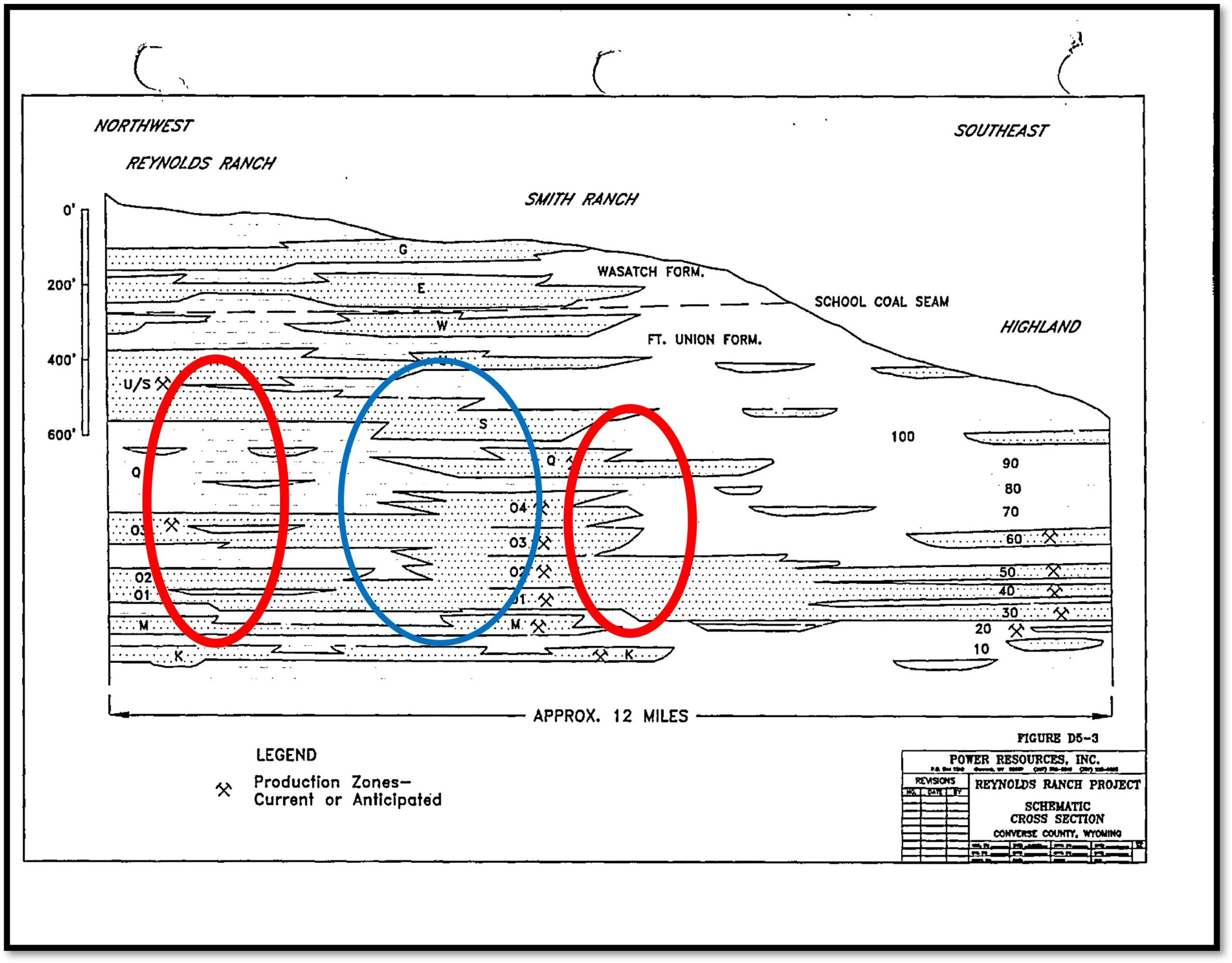
Reynold Ranch immediate west of Duck Creek deposit
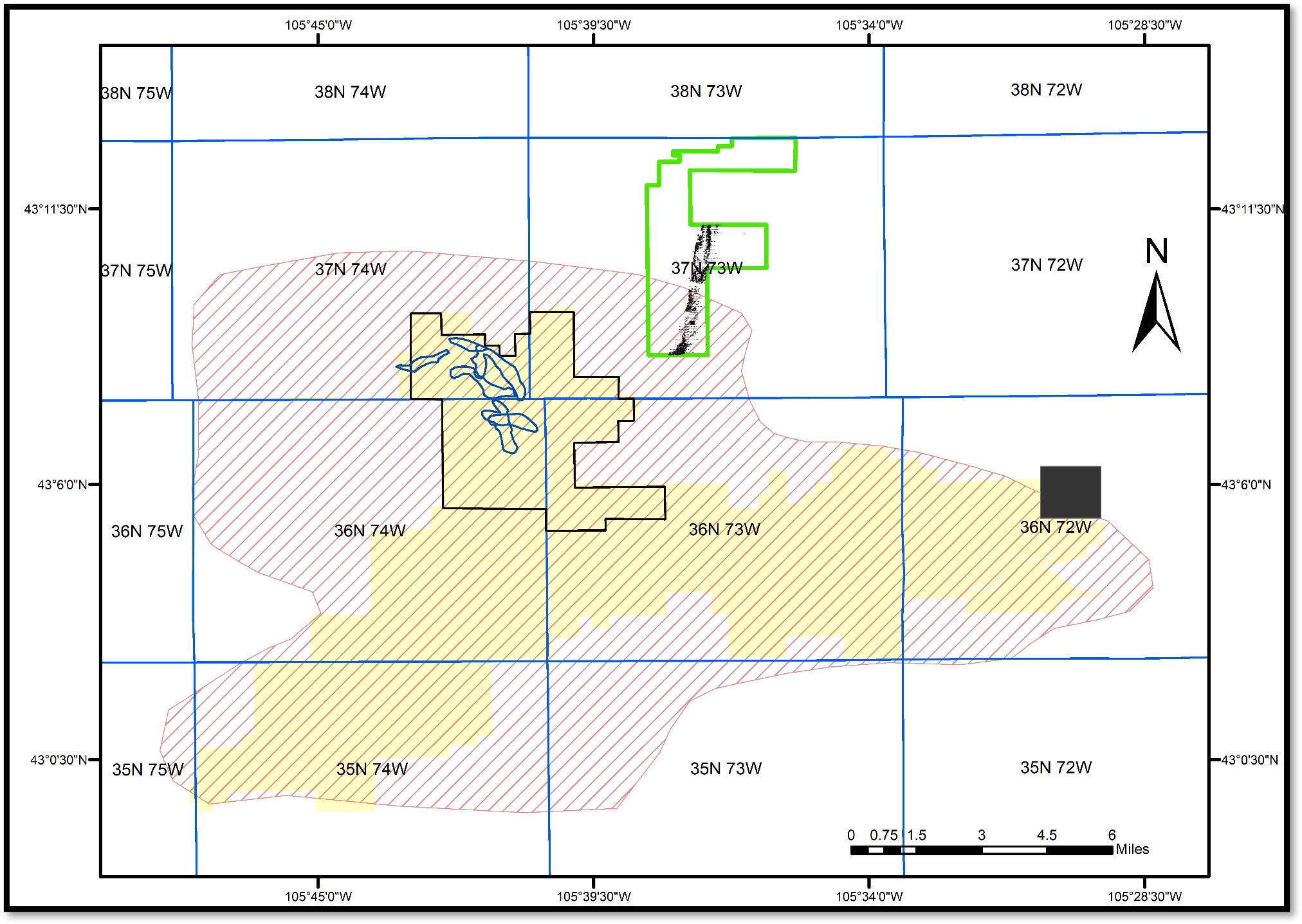
Conclusions
- Current estimated resources: Between 1.4M – 4.2Mlbs U₃O₈. amenable by HPSA method
- Upside potential: Particularly in the deeper Fort Union Formation
- Future work required: Verification drilling, geophysical logging, geochemical analysis and a hydrological study.
- A robust Exploration program and budget will be prepared in the light of NI43-101 in the 2nd quarter 2025.
- UNXE238 Corp. is actively looking for partners for a joint venture to advance the exploration activities.
Recommendations for further Development & Operations
Next Steps
- Prepare a non-coal Drilling Notification (DN) required by the Wyoming Department of Environmental Quality/Land Quality Division (WDEQ/LQD) in order to explore by drilling.
- Verification drilling, geophysical logging, and prompt fission neutron (PFN)
- logging could confirm historical estimates, provide disequilibrium data, and allow conversion to classified resources.
- Complete exploration drilling in the Fort Union to determine if additional mineralized zones are present.
- Water level data should be collected during exploration and verification drilling to determine which intervals are saturated.
- Core samples should be collected and tested in a laboratory setting to confirm the level of radiometric equilibrium unless prompt fission neutron logging is employed
